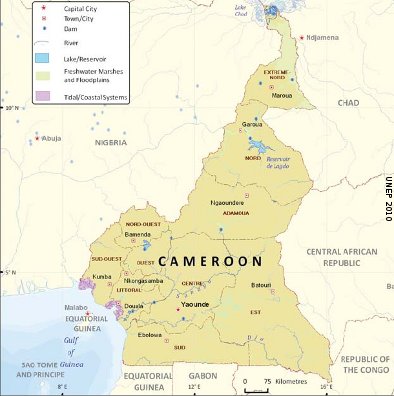Southern Cameroon has an average temperature of about 25°C. In the extreme north of the country daily temperatures are very high, usually between 25°C and 34°C, with large amount of sunshine.
The country has two distinct climatic regions: the humid equatorial region in the south and the semi-arid northern portion extending into the Sahel. In the humid southern region annual rainfall often averages 1500mm, while in the north it averages 500mm.
Cameroon’s economy predominantly agrarian and agriculture, the exploitation of natural resources remain the driving force for the country’s economic development.. Agriculture is a vital sector involving 80% of the population contributing about 30% of Cameroon’s GDP. Fluctuations in national income are due not merely to the decline in world demand for Cameroon’s traditional agricultural exports but also to the vagaries of weather meaning climate change plays a big role in determining national income.
Climate change in Cameroon
Since the agricultural system is still highly dependent on climate, as temperature, light, and water are the main drivers of crop growth. Plant diseases and pest infestations, as well as the supply of and demand for irrigation water, are also influenced by climate. The key uncertainty, therefore, for agricultural outlook in the country is future climate change and its relationship with availability of water and soil moisture. Current climate variation is already altering the types, frequencies, and intensities of crop and livestock pests and diseases, the availability and timing of irrigation water supplies, and the severity of soil erosion.
Therefore agriculture in Cameroon is limited by the seasonality and amount of moisture availability. Drought has triggered an increased migration of pastoralists and nomads from the northern part of the country to the south. The observed decline in rainfall in the region is thought to contribute to the increasing desertification in northern Cameroon, leading to shifts in the ecological zones and an increasing exploitation of marginal ecosystems.
Climate change response strategies and WACDEP Programme Implementation
The national policy of Cameroon tries to integrate the contribution of all social groups and stakeholders for planning, development and implementation of adaptation policies and climate change response strategies. The WACDEP Programme is quite timely in the sense that issues surrounding the drying up of the Lake Chad, shall be diagnosed for appropriate actions to be taken in future development planning. Primary focus areas shall thus need to be involved with key government agencies and other stakeholders during programme implementation.
The programme should aim to enhance the countries’ ability to carry out reliable climate forecasts and predictions of future scenarios and establish a sound basis for defining adaptation measures through better water management. WACDEP can contribute to the mainstreaming of adaptation into development and increase the capacity to formulate relevant policies and raise awareness of different stakeholders. It is crucial for communities and farmers to adopt new practices and coping strategies in response to the altered conditions and WACDEP can as well offer support.
